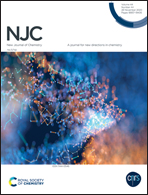A highly sensitive and selective fluorescent turn-on chemosensor bearing a 7-diethylaminocoumarin moiety for the detection of cyanide in organic and aqueous solutions†
Abstract
New Schiff bases bearing a salicylidene moiety with different substituents and 7-diethylaminocoumarin-thiazole were synthesized and characterized using spectroscopic methods. Also, four of the synthesized compounds (4, 6, 7, and 9) were characterized using X-ray analysis. The chemosensor properties of the compounds (4–9) were investigated using UV-vis and fluorescence spectroscopy as well as visual changes, and it was found that the compounds except 7 showed selectivity to cyanide anions in both organic and aqueous solutions, observed by the drastic increment in emission intensity. The mechanism of interaction between the cyanide anions and imine carbon at the Schiff base was determined using the 1H NMR titration method. The determination of the thermal stability of the compounds was performed using thermogravimetric analysis (TGA). Density Functional Theory (DFT) calculations were also employed to gain insights into the experimental data.



 Please wait while we load your content...
Please wait while we load your content...